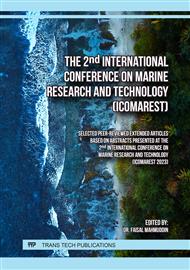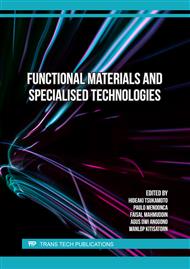[1]
B. Shaqour et al., "Gaining a better understanding of the extrusion process in fused filament fabrication 3D printing: a review," Int. J. Adv. Manuf. Technol., vol. 114, no. 5–6, p.1279–1291, 2021.
DOI: 10.1007/s00170-021-06918-6
Google Scholar
[2]
T. Hachimi, N. Naboulsi, F. Majid, R. Rhanim, I. Mrani, and H. Rhanim, "Design and Manufacturing of a 3D printer filaments extruder," Procedia Struct. Integr., vol. 33, no. C, p.907–916, 2021.
DOI: 10.1016/j.prostr.2021.10.101
Google Scholar
[3]
N. G. Tanikella, B. Wittbrodt, and J. M. Pearce, "Tensile strength of commercial polymer materials for fused filament fabrication 3D printing," Addit. Manuf., vol. 15, p.40–47, 2017.
DOI: 10.1016/j.addma.2017.03.005
Google Scholar
[4]
D. Deb and J. M. Jafferson, "Natural fibers reinforced FDM 3D printing filaments," Mater. Today Proc., vol. 46, p.1308–1318, 2021.
DOI: 10.1016/j.matpr.2021.02.397
Google Scholar
[5]
M. R. Khosravani and T. Reinicke, "On the environmental impacts of 3D printing technology," Appl. Mater. Today, vol. 20, p.100689, 2020.
DOI: 10.1016/j.apmt.2020.100689
Google Scholar
[6]
B. I. S. Murat, M. S. Kamalruzaman, M. H. N. Azman, and M. F. Misroh, "Assessment of Mechanical Properties of Recycled HDPE and LDPE Plastic Wastes," IOP Conf. Ser. Mater. Sci. Eng., vol. 957, no. 1, p.0–7, 2020.
DOI: 10.1088/1757-899X/957/1/012046
Google Scholar
[7]
M. A. Kreiger, M. L. Mulder, A. G. Glover, and J. M. Pearce, "Life cycle analysis of distributed recycling of post-consumer high density polyethylene for 3-D printing filament," J. Clean. Prod., vol. 70, p.90–96, 2014.
DOI: 10.1016/j.jclepro.2014.02.009
Google Scholar
[8]
S. Chong, G.-T. Pan, M. Khalid, T. C.-K. Yang, S.-T. Hung, and C.-M. Huang, "Physical Characterization and Pre-assessment of Recycled High-Density Polyethylene as 3D Printing Material," J. Polym. Environ., vol. 25, no. 2, p.136–145, 2017.
DOI: 10.1007/s10924-016-0793-4
Google Scholar
[9]
A. Gudadhe, N. Bachhar, A. Kumar, P. Andrade, and G. Kumaraswamy, "Three-Dimensional Printing with Waste High-Density Polyethylene," ACS Appl. Polym. Mater., vol. 1, no. 11, p.3157–3164, Nov. 2019.
DOI: 10.1021/acsapm.9b00813
Google Scholar
[10]
P. Górak, P. Postawa, and L. N. Trusilewicz, "Lightweight composite aggregates as a dual end-of-waste product from PET and anthropogenic materials," J. Clean. Prod., vol. 256, p.120366, 2020.
DOI: 10.1016/j.jclepro.2020.120366
Google Scholar
[11]
V. Harshitha and S. Srinivasa Rao, "Design and analysis of ISO standard bolt and nut in FDM 3D printer using PLA and ABS materials," Mater. Today Proc., vol. 19, p.583–588, 2019.
DOI: 10.1016/j.matpr.2019.07.737
Google Scholar
[12]
et al. Mustapha, Rohani, "tudy on Renewable Resource-Based Composites from Agro Waste Alpinia Galanga Natural Fibers," Adv. Mater. Res. vol. 626, Trans Tech Publ. Ltd.,.
DOI: 10.4028/www.scientific.net/amr.626.756
Google Scholar
[13]
R. Mustapha, M. Awang, and S. N. H. Mustapha, "the Effect of Chemical Treatments on the Properties of Alpinia Galanga/High-Density Polyethylene (Hdpe)-Eco Degradant Composites," J. Eng. Sci. Technol., vol. 17, no. 3, p.2176–2191, 2022.
DOI: 10.4028/www.scientific.net/amm.534.75
Google Scholar
[14]
R. R. Badu, C. W. Purnomo, and B. Kamulyan, "Plastic Waste Recycle into Pellet: Economic Analysis and Processing Temperature Effects," Key Eng. Mater., vol. 920, p.129–136, 2022.
DOI: 10.4028/p-t0ac0q
Google Scholar
[15]
M. A. Yusof, N. H. N. Rahman, S. Z. Sulaiman, A. H. Sofian, M. S. Z. M. Desa, and I. Izirwan, "Development of low density polyethylene/graphene nanoplatelets with enhanced thermal properties," in 2018 IEEE 9th International Conference on Mechanical and Intelligent Manufacturing Technologies (ICMIMT), IEEE, 2018, p.6–9.
DOI: 10.1109/icmimt.2018.8340411
Google Scholar
[16]
M. Rismalia, S. C. Hidajat, I. G. R. Permana, B. Hadisujoto, M. Muslimin, and F. Triawan, "Infill pattern and density effects on the tensile properties of 3D printed PLA material," in Journal of Physics: Conference Series, 2019.
DOI: 10.1088/1742-6596/1402/4/044041
Google Scholar



